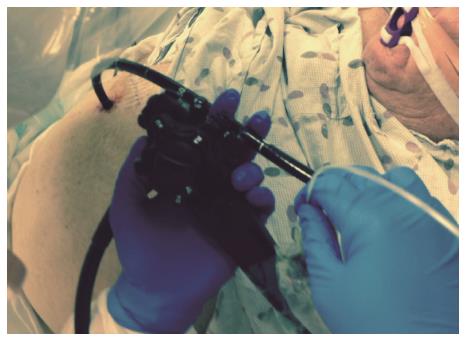Copyright
©2014 Baishideng Publishing Group Inc.
World J Surg Proced. Jul 28, 2014; 4(2): 23-32
Published online Jul 28, 2014. doi: 10.5412/wjsp.v4.i2.23
Published online Jul 28, 2014. doi: 10.5412/wjsp.v4.i2.23
Figure 6 Example of transgastric endoscopic retrograde cholangiopancreatography in a patient with Roux-en-Y gastric bypass anatomy who underwent laparoscopic cholecystectomy and had an intraoperative cholangiogram that was suspicious for small, non-obstructing, bile duct stones.
A 36-Fr Malecot tube had been left across a surgical Stamm gastrostomy. Endoscopic retrograde cholangiopancreatography in the supine position (under general anesthesia) was performed two weeks after surgical gastrostomy using a therapeutic duodenoscope. Despite an awkward scope position requiring the stabilization of the duodenoscope shaft using the left hand (as might be seen during complex colonoscopic polypectomy), biliary sphincterotomy and stone removal were successful.
- Citation: Cosgrove ND, Wang AY. Endoscopic approaches to biliary intervention in patients with surgically altered gastroduodenal anatomy. World J Surg Proced 2014; 4(2): 23-32
- URL: https://www.wjgnet.com/2219-2832/full/v4/i2/23.htm
- DOI: https://dx.doi.org/10.5412/wjsp.v4.i2.23









